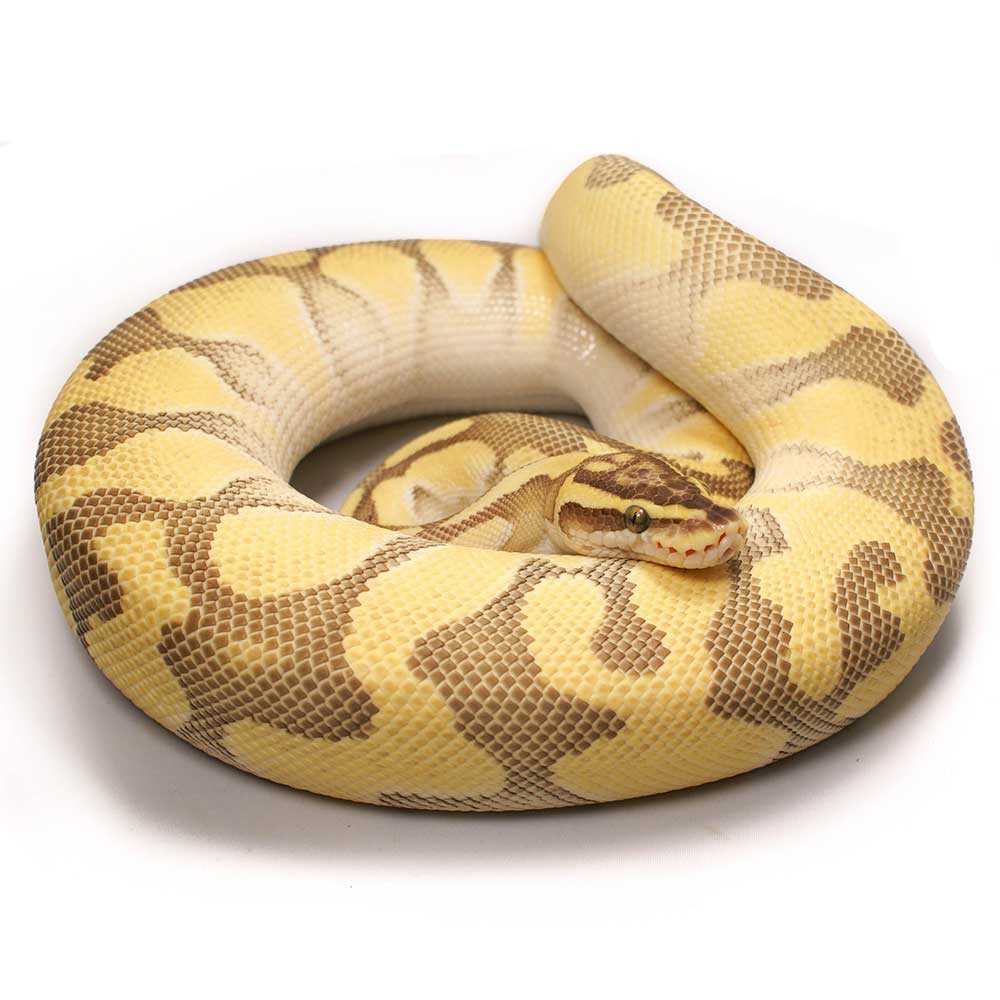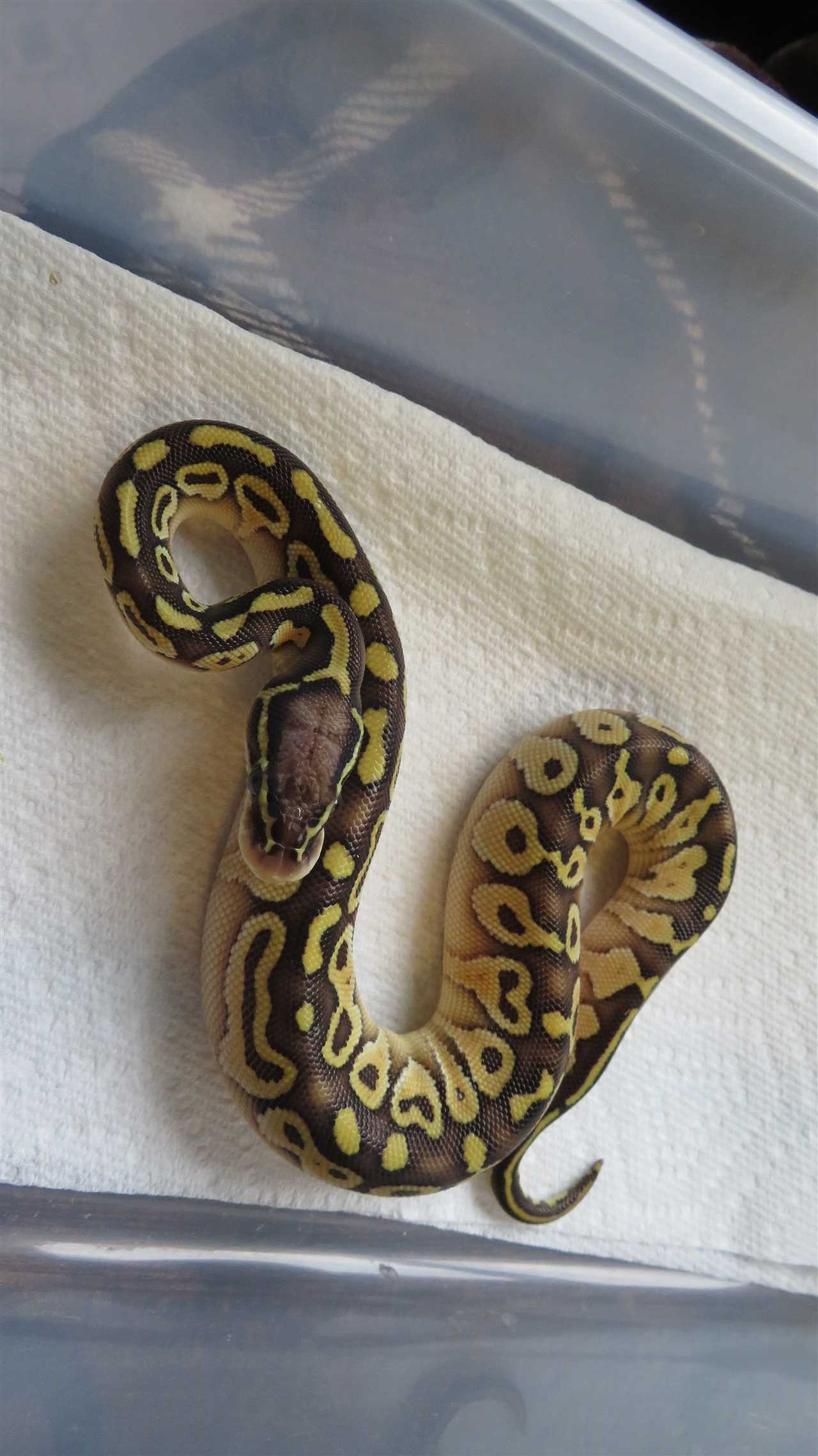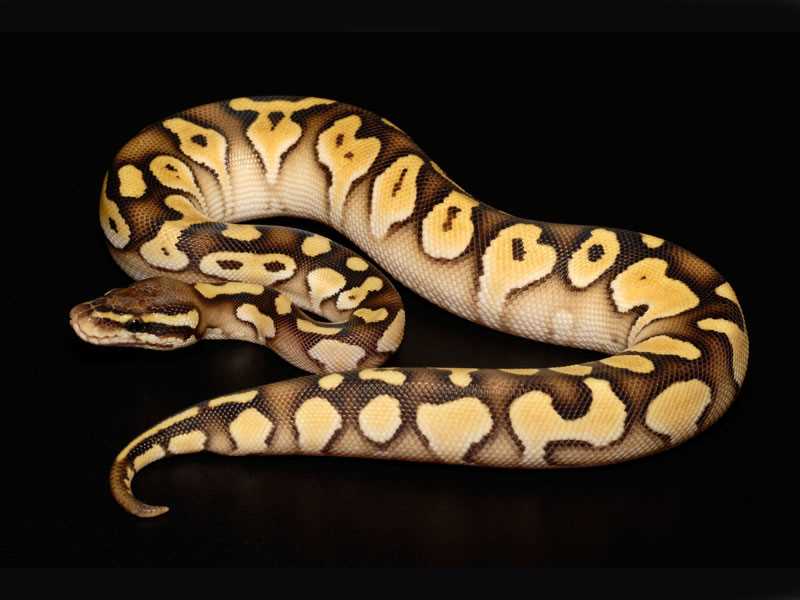
The combination of the Lesser gene with the Pastel gene intensifies the colors, creating a snake that is even more stunning. The Pastel gene enhances the overall brightness and saturation of the colors, making the Ball Python Lesser Pastel simply mesmerizing to look at. From its vibrant oranges, yellows, and browns to its clean and crisp patterns, this morph stands out among the rest.
Not only is the Ball Python Lesser Pastel visually appealing, but it also has a calm and docile temperament, which makes it an excellent choice for both beginner and experienced snake keepers. Its small to medium size and easygoing nature make it an ideal pet for those looking to enter the world of snake ownership. However, as with all reptiles, proper care, handling, and enclosure setup are crucial for the well-being of the snake.
What is a Ball Python Lesser Pastel?
A Ball Python Lesser Pastel is a specific morph of the ball python, a popular snake species among reptile enthusiasts. This morph is the result of breeding a Lesser Ball Python with a Pastel Ball Python, resulting in a snake with distinctive and beautiful characteristics.
Appearance and Coloration
The Ball Python Lesser Pastel has a striking appearance and coloration that sets it apart from other ball python morphs. It exhibits a light brown to tan base color, with thin dark brown to black striping or blotching along its body. The striping can vary in intensity, and some individuals may have reduced or faded striping patterns.
In addition to the striping, the Ball Python Lesser Pastel often displays vibrant yellow or gold highlights along its sides, particularly on the belly scales. These highlights give the snake a distinctive and eye-catching appearance.
Genetics and Breeding
To produce a Ball Python Lesser Pastel, breeders must have a Lesser Ball Python and a Pastel Ball Python. When these two morphs are bred together, the offspring will inherit both the Lesser and Pastel genes, resulting in the Ball Python Lesser Pastel morph.
The Lesser gene is responsible for reducing the amount of black pigmentation in the snake’s markings, while the Pastel gene enhances the overall coloration and creates the vibrant yellow highlights.
Breeders often pair Ball Python Lesser Pastels with other morphs to create unique combinations and patterns.
Caring for a Ball Python Lesser Pastel
Caring for a Ball Python Lesser Pastel is similar to caring for other ball python morphs. They require a suitable enclosure with proper heating and humidity levels, a proper diet consisting of appropriately-sized prey, and regular veterinary check-ups for overall health and well-being.
| Enclosure Size | Temperature | Humidity | Diet |
|---|---|---|---|
| 20-30 gallon tank for juveniles, 40 gallon tank or larger for adults | 80-85°F (26-29°C) on warm side, 75-80°F (24-27°C) on cool side | 50-60% humidity | Prey items that are appropriately sized for the snake’s girth |
Handling and Temperament
Regular and gentle handling can help build trust and ensure a positive relationship between the snake and its owner.
Common Health Issues
Like all ball pythons, Ball Python Lesser Pastels are susceptible to some common health issues, such as respiratory infections, scale rot, and mites. It’s essential to provide appropriate husbandry conditions, regular veterinary check-ups, and a clean enclosure to prevent these issues.
Availability and Pricing
Ball Python Lesser Pastels are relatively popular among snake enthusiasts and are readily available in the reptile trade. The price of a Ball Python Lesser Pastel can vary depending on factors such as age, size, coloration, and lineage.
Appearance and Coloration
The Ball Python Lesser Pastel is a stunning morph of the ball python, known for its vibrant colors and distinct patterns. This morph is a combination of the Lesser and Pastel morphs, resulting in a snake with a unique appearance that stands out from the crowd.
The Ball Python Lesser Pastel typically has a light cream or yellow base color, with darker brown or black markings and patterns. The markings can vary from snake to snake, but they often consist of blotches, stripes, or a combination of both. These markings create a beautiful contrast against the lighter background color.
Coloration Variations
While the Ball Python Lesser Pastel generally has a light cream or yellow base color, there are some variations that can occur. Some individuals may have a slightly more brown or tan base color, while others may have a more prominent yellow hue. Additionally, the dark markings can range in color from brown to black, creating further variation in appearance.
These variations in coloration make each Ball Python Lesser Pastel unique, adding to their appeal as pets and collector’s animals. Whether you prefer a lighter pastel look or a snake with more intense and contrasting colors, there is likely a Ball Python Lesser Pastel that will catch your eye.
Genetics and Breeding
The Ball Python Lesser Pastel is a popular morph in the ball python world. It is a combination of two co-dominant morphs: the Lesser and the Pastel. The Lesser morph is known for its characteristic “belly blushing,” which results in a lighter underside compared to the rest of its body. The Pastel morph, on the other hand, enhances the coloration of the snake, making it brighter and more vibrant.
When bred together, two Ball Python Lesser Pastels will produce a clutch of eggs that contain a variety of morphs. Approximately 25% of the offspring will be Ball Python Lesser Pastels, 25% will be Lesser morphs, 25% will be Pastel morphs, and 25% will be normal wild-type ball pythons. This is due to the co-dominant nature of both the Lesser and Pastel genes.
Breeding Considerations
Market Demand and Future Potential
The Ball Python Lesser Pastel is a highly sought-after morph in the ball python market. Its unique coloration and genetic makeup make it a popular choice among snake enthusiasts and collectors. As such, the demand for Ball Python Lesser Pastels remains high, which can result in higher prices compared to other morphs.
Furthermore, the future potential of the Ball Python Lesser Pastel lies in its ability to produce new and exciting morphs. By selectively breeding Ball Python Lesser Pastels with other morphs, breeders have the opportunity to create unique combinations and patterns. This opens up possibilities for even more diverse and visually appealing ball python morphs in the future.
Caring for a Ball Python Lesser Pastel: A Comprehensive Guide
Habitat Setup
Provide a temperature gradient within the enclosure, with one side of the tank being warmer (around 88-92°F) and the other side cooler (around 78-82°F). This temperature difference allows your ball python lesser pastel to regulate their body temperature effectively. Utilize heating elements such as heat mats or ceramic heat emitters, along with thermostats to ensure accurate and consistent temperature control.
Nutrition and Feeding
Feed your ball python lesser pastel once every 7-10 days for young snakes, and once every 10-14 days for adults. Provide a separate feeding enclosure to avoid any substrate ingestion during feeding. After the feeding, always ensure that your snake has access to clean, fresh water for hydration.
Handling and Enrichment
Handle your ball python lesser pastel with care and always approach them slowly and confidently. Start by offering a hand or arm for them to explore and gradually increase the amount of handling over time. Avoid excessive or rough handling, as it can cause stress to your snake.
Ball pythons are crepuscular and nocturnal, so provide them with plenty of places to hide and feel secure during the day. Adding several hiding spots throughout the enclosure, such as caves, branches, and snug hides, will give your ball python lesser pastel the option to retreat and feel safe. Additionally, provide some climbing opportunities, branches, and sturdy decorations to encourage natural behaviors and enrichment.
Health and Common Issues
Regularly monitor your ball python lesser pastel for any signs of illness or distress. Common health issues in ball pythons include respiratory infections, mouth rot, skin shedding problems, and internal parasites. Ensure that the enclosure is kept clean and hygienic at all times, and provide a proper temperature and humidity gradient to prevent these issues.
If you notice any abnormal behavior, loss of appetite, difficulty breathing, or any other concerning symptoms, consult a reptile veterinarian immediately for a professional diagnosis and treatment.
Feeding and Nutrition
One important thing to note is that Ball Python Lesser Pastels have a slower metabolism compared to other ball python morphs. This means that they may not require feeding as frequently. It’s generally recommended to feed adult Lesser Pastels every 7-10 days, while younger snakes may require feeding every 5-7 days.
Prey Size
Feeding Techniques
There are a few different feeding techniques that can be used for Ball Python Lesser Pastels. One common method is using frozen-thawed prey, which is readily available and eliminates the risk of live prey injuring the snake. The frozen prey should be thawed using warm water and offered to the snake using tongs.
Supplements
Overall, providing a proper diet and nutrition is essential for the health and well-being of a Ball Python Lesser Pastel. By offering appropriately-sized prey, using safe feeding techniques, and providing necessary supplements, you can help your snake thrive.
Housing and Enclosure for a Ball Python Lesser Pastel
Size of the enclosure: A fully-grown Ball Python Lesser Pastel requires a spacious enclosure that allows them to stretch out and move around freely. A 40-gallon terrarium is generally suitable for an adult python, but larger enclosures are recommended if available.
Temperature and humidity: Maintain a temperature gradient within the enclosure. One side of the enclosure should have a warm spot ranging from 88-92°F (31-33°C), while the other side should be cooler, around 78-80°F (25-27°C). Use a combination of under-tank heating pads and ceramic heat emitters to achieve and regulate these temperatures. The humidity levels should be kept between 50-60%. Provide a humidity hide filled with damp sphagnum moss to aid shedding.
Lighting: Ball Python Lesser Pastels are primarily nocturnal and do not require UVB lighting. However, providing a low-level light source can help maintain natural day and night cycles. A simple LED light or a low-wattage incandescent bulb can be used for this purpose.
Enrichment: Add appropriate hiding spots, branches, and other climbing materials to the enclosure to mimic the python’s natural habitat and provide mental stimulation. This will help prevent stress and promote natural behaviours.
Cleaning: Regularly clean and disinfect the enclosure to maintain a hygienic living environment for your python. Remove soiled substrate, replace water dishes regularly, and spot clean any debris or waste.
Monitoring: Keep a close eye on the temperature and humidity levels within the enclosure using reliable thermometers and hygrometers. Regularly check for any signs of illness or injury in your python, such as changes in appetite, lethargy, or abnormal shedding patterns.
Providing a suitable housing and enclosure for your Ball Python Lesser Pastel is crucial for their health and well-being. By ensuring the right temperature, humidity, substrate, and enrichment, you can create an environment that allows your python to thrive and showcase their natural behavior. Regular monitoring and cleaning will help maintain a hygienic and stress-free environment, promoting the overall health of your python.
Handling and Temperament
Before handling your python, make sure that you have thoroughly washed your hands to remove any lingering scents that could potentially startle or stress the snake. It is always recommended to handle them gently and support their body to prevent any accidental injuries.
When handling your Ball Python Lesser Pastel, it is crucial to avoid sudden movements or loud noises that may startle them. This can cause stress and potentially lead to defensive behavior such as hissing or striking. Instead, move slowly and confidently to help them feel secure and relaxed.
It is also important to note that handling should be kept to a minimum, especially during periods of shedding, feeding, or when the snake is in a state of rest. Snakes do require some alone time and excessive handling can be stressful for them.
Common Health Issues of Ball Python Lesser Pastel
1. Respiratory Infections
2. Scale Rot
Scale rot is a common issue in ball pythons, including the Lesser Pastel morph. It is caused by poor husbandry practices, such as keeping the enclosure too wet or dirty. Scale rot appears as discolored or crusty scales, and it can lead to infections if left untreated. Maintaining proper humidity levels and keeping the enclosure clean can help prevent scale rot.
3. Parasites

Parasites, such as mites and ticks, can infest ball pythons, including the Lesser Pastel variety. They can cause skin irritation, anaemia, and other health problems if not addressed promptly. Regularly inspecting your snake for parasites and providing appropriate treatment is crucial for their well-being.
4. Mouth Rot
5. Obesity
Ball Python Lesser Pastel vs Other Morphs

The Lesser Pastel is a combination of two morphs, the Lesser and the Pastel. The Lesser morph is known for its reduced pattern and faded colors, while the Pastel morph enhances the overall coloration and creates a lighter and brighter appearance.
Compared to other morphs, the Ball Python Lesser Pastel has a distinct look that sets it apart. Its reduced pattern and faded colors give it a clean and sleek appearance, while the pastel influence adds a touch of brightness to its scales. The combination of these two morphs creates a visually striking and unique snake.
One of the main advantages of the Ball Python Lesser Pastel is its genetic makeup. The Lesser gene is a co-dominant gene, meaning that when bred with another morph, the offspring will exhibit the traits of both morphs. This makes it a valuable morph for breeders who want to create visually appealing and genetically diverse snakes.
Availability and pricing can also play a role in your decision-making process. The Ball Python Lesser Pastel is a popular and sought-after morph, so it is generally readily available in the market. However, due to its popularity and genetic desirability, it may be priced slightly higher compared to other morphs.
Availability and Pricing
Ball Python Lesser Pastels are highly sought-after morphs in the reptile trade. Due to their striking appearance and unique genetics, they are often in high demand among snake enthusiasts and collectors.
When purchasing a Ball Python Lesser Pastel, it is essential to do thorough research and buy from a reputable breeder. This ensures that you are getting a healthy snake with accurate genetics, and also supports responsible breeding practices.
| Availability | Pricing |
|---|---|
| Varies depending on the region and breeder | Range from $200 to $1000 or more |

I’m Lena Adams—a product of an unconventional upbringing in the African wilderness. My father, a daring explorer of African wildlife, sparked my fascination with reptiles, a passion that intertwined with the tragic loss of my mother during an expedition, leaving an indelible mark on my life. Driven to understand the creatures that captivated my parents, I embarked on my journey, sharing insights about reptiles, frogs, and lizards on my website. Through my explorations and conservation efforts, I honour my family’s legacy while seeking connections—to the creatures, nature, and the mother whose presence I yearn to understand.
